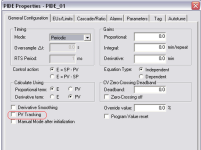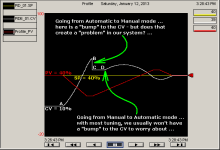MATT116
Member
RS5000 V20
1756-L71
FTview 6.1 with PIDE face plate
My question, is there is a way to get bumpless transfer from operator manual mode to program auto mode?
Right now if Im in program auto mode and my CV is 50% and then I enter operator manual from the face plate then adjust the CV to 75% then return to program auto mode the CV jumps back to 50%. I know it works going program manual to program auto. Any ideas?
Thanks
1756-L71
FTview 6.1 with PIDE face plate
My question, is there is a way to get bumpless transfer from operator manual mode to program auto mode?
Right now if Im in program auto mode and my CV is 50% and then I enter operator manual from the face plate then adjust the CV to 75% then return to program auto mode the CV jumps back to 50%. I know it works going program manual to program auto. Any ideas?
Thanks





